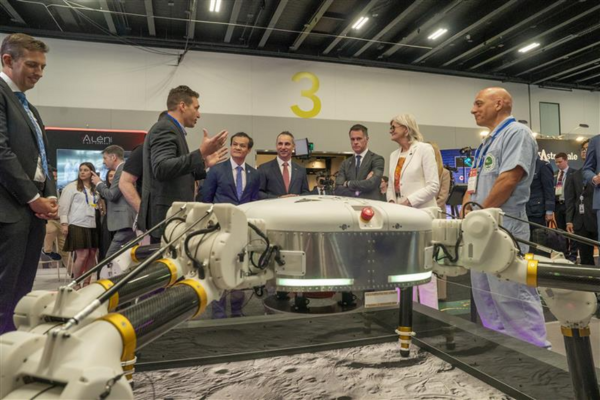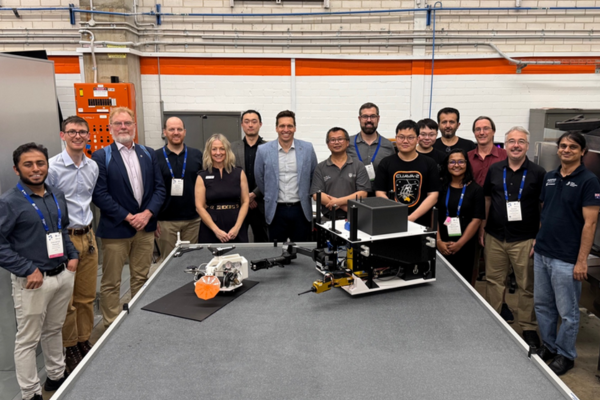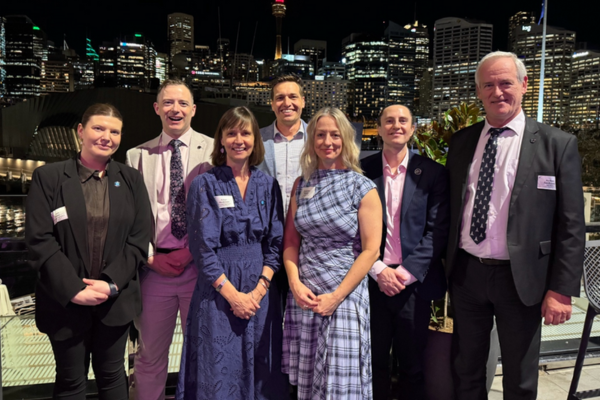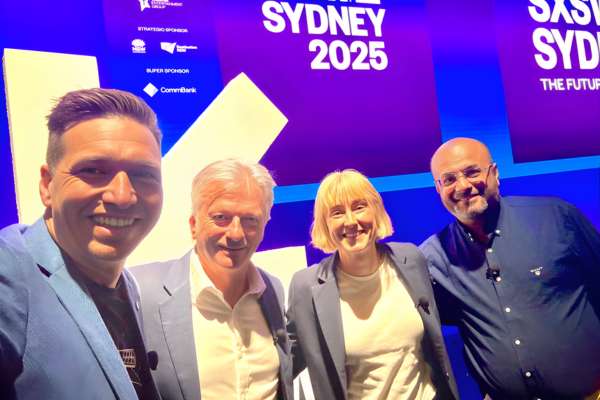It has been a busy and rewarding month for the SmartSat research team and our partners, as we showcased our achievements and collaborations across Australia.
The highlight has of course been the International Astronautical Congress (IAC) 2025 in Sydney last month. Day one started with a briefing with the Governor General of Australia, the Honourable Sam Mostyn AC; the Senator the Hon Tim Ayers, Minister for Industry and Innovation and Minister for Science; the Hon Chris Minns, Premier of New South Wales (NSW); and NSW Minister for Innovation, Science and Technology, the Hon Anoulack Chanthivong.
SmartSat managed and provided technical oversight to the NSW Space+ project, funded by Investment NSW, for their technology development for IAC. The project team of Crest Robotics and Earthbuilt Technology team developed the Charlotte 6-legged robot, giving live demonstrations on the NSW display at IAC.
 Dr Carl Seubert presenting the NSW Space+ robot Charlotte during a live demo to NSW Minister for Innovation, Science and Technology, the Hon Anoulack Chanthivong; Head of the Australian Space Agency, Enrico Palermo; the Hon Chris Minns, Premier of NSW; Governor General of Australia, the Honourable Sam Mostyn AC; with research team leads, Clyde Webster from Crest Robotics and Jan Golembiewski from Earthbuilt Technology.
Dr Carl Seubert presenting the NSW Space+ robot Charlotte during a live demo to NSW Minister for Innovation, Science and Technology, the Hon Anoulack Chanthivong; Head of the Australian Space Agency, Enrico Palermo; the Hon Chris Minns, Premier of NSW; Governor General of Australia, the Honourable Sam Mostyn AC; with research team leads, Clyde Webster from Crest Robotics and Jan Golembiewski from Earthbuilt Technology.
Also in Sydney, we were lucky to attend a live demonstration of the culmination of the ISAM project (P2.59 In-Orbit Servicing, Assembly, and Manufacturing) at the University of Sydney, along with a number of lab tours and demonstrations across the campus. A great showing of academics, students and the technologies under development.
 The University of Sydney ISAM project team along with SmartSat research team members (L-R) Defence and National Security Coordinator, Peter Kerr; Research Program Manager, Dr Andrew Barton; Research Portfolio Manager, Elizabeth Weeks; and Chief Research Officer, Carl Seubert.
The University of Sydney ISAM project team along with SmartSat research team members (L-R) Defence and National Security Coordinator, Peter Kerr; Research Program Manager, Dr Andrew Barton; Research Portfolio Manager, Elizabeth Weeks; and Chief Research Officer, Carl Seubert.
As well as being an extraordinary showcase of Australia’s and the world’s space industry the IAC gave a great opportunity to engage with our colleagues from the New Zealand Space Agency and Ministry of Business, Innovation and Employment (MBIE) to reflect on the Phase 1 Collaborative Space Program research projects and prepare for the upcoming Phase 2.
 (L-R) Jess Dallas, Policy Team Leader at MBIE; Deputy Head and Head of the New Zealand Space Agency, Andrew Johnson and Robyn Henderson; SmartSat Chief Research Officer and Research Portfolio Manager, Dr Carl Seubert and Elizabeth Weeks; Senior Policy Manager at the New Zealand Space Agency, Hoani Hakaraia; and Chief of Space, Intelligence, National Security and Cyber (SINC) Division within the Defence Science and Technology Group, Andrew Seedhouse.
(L-R) Jess Dallas, Policy Team Leader at MBIE; Deputy Head and Head of the New Zealand Space Agency, Andrew Johnson and Robyn Henderson; SmartSat Chief Research Officer and Research Portfolio Manager, Dr Carl Seubert and Elizabeth Weeks; Senior Policy Manager at the New Zealand Space Agency, Hoani Hakaraia; and Chief of Space, Intelligence, National Security and Cyber (SINC) Division within the Defence Science and Technology Group, Andrew Seedhouse.
Sydney was a great setting for the team to meet with our Lithuanian-based collaborators from Blackswan Space in-person. Along with our partners at University of Adelaide and Infinity Avionics, we had the opportunity to have technical discussions regarding recently kicked-off SmartSat and Defence Trailblazer project to develop the Event-based Sensing Payload for Autonomous Rendezvous Control (P2-68 E-SPARC). We also had an encouraging discussion with the Lithuanian Ambassador, His Excellency Darius Degutis.
SmartSat had a number of projects, particularly Kanyini, highlighted through research papers presented at IAC, including:
- Kanyini R&D: Innovative EO Applications Adding Socio-Economic Impact to an Australian CubeSat [SmartSat led]
- Kanyini Mission: Methodology, Approach, and Insights from Australia’s First State-Funded EO Mission [SmartSat led]
- Daily Urban Land Surface Temperature Measurement and Modelling Using Multiple Passive TIR Satellite Sensors, including Kanyini [SmartSat led]
- Ground Motion Compensation Demonstration and Assessment – Kanyini CubeSat In-Orbit Results
- The Takahē Mission Concept – Southern Indo-Pacific Ocean Monitoring from Space [SmartSat led]
- Advancing the SatPing Initiative for Safer Space Operations
- Same Same, but Different: The Necessity of a Specific Legal Framework Tailored for Space Cybersecurity
- Field Trial of LunaSAR: Evaluating a Resilient Emergency Communications System for Future Lunar Search and Rescue Service
- Distributed Learning-Driven Design for Cyber Secure Space Constellation Network
- Distributed Autonomous Mission Planning for Resource-Constrained Satellites: Implementation on the Buccaneer Main Mission Cubesat
Finally, at South by Southwest (SxSW) Sydney, I had the privilege of being on a panel hosted by former Australian cricketer, Steve Waugh AO, on the topic of space being Australia’s new sporting arena.
Along with co-founder and Chief Executive Officer of Space Machines Company, Rajat Kulshrestha, and co-founder and Chief Executive Officer of Deneb Space, Anne Bettens, we had an enlightening and fun exploration into Australia’s role and opportunities in the global space sectors, parallels between sport and technical programs and the idea of academies to build talent and excel and our ‘Aussie spirit’ to engineer space systems.
 SmartSat Chief Research Officer, Dr Carl Seubert with former Australian cricketer, Steve Waugh AO; Deneb Space Co-founder and Chief Executive Officer, Anne Bettens; and Space Machines Company Chief Executive Officer, Rajat Kulshrestha.
SmartSat Chief Research Officer, Dr Carl Seubert with former Australian cricketer, Steve Waugh AO; Deneb Space Co-founder and Chief Executive Officer, Anne Bettens; and Space Machines Company Chief Executive Officer, Rajat Kulshrestha.
These activities underscore SmartSat’s leadership in advancing Australia’s space ecosystem, fostering international collaboration, and showcasing the real-world impact of our research partnerships.
Dr Carl Seubert
Chief Research Officer
Feature image: The international E-SPARC team meeting the Lithuanian Ambassador His Excellency Mr Darius Degutis